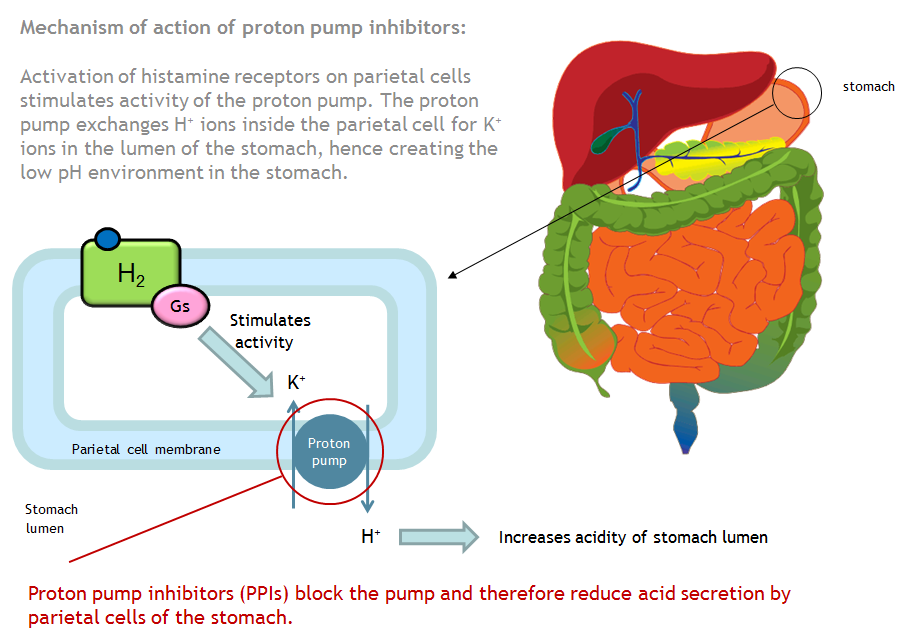Proton Pump Inhibitors
Examples
- Omeprazole
- Lansoprazole
- Esomeprazole
- Pantoprazole
Indications
Treatment of gastric and duodenal ulcers, H.Pylori eradication, dyspepsia, gastro-oesophageal reflux disease, prevention and treatment of NSAID-associated ulcers and for reducing acid secretion in rare conditions such as Zollinger-Ellison syndrome.
There have been recent concerns about the widespread prescribing of PPIs, particularly unnecessary ongoing maintenance treatment at high doses.
Unlicensed use: Treatment of major peptic ulcer bleeding
There have been recent concerns about the widespread prescribing of PPIs, particularly unnecessary ongoing maintenance treatment at high doses.
Unlicensed use: Treatment of major peptic ulcer bleeding
Contraindications
Contraindications
- No specific contraindications, but it is cautioned that using PPI's may disguise symptoms of gastric cancer
- Liver disease
- Pregnancy and breast feeding
Mechanism
PPIs work by reducing the acid secretion of parietal cells in the stomach. They do this by inhibiting the proton pump. Normally the proton pump exchanges H+ ions in the parietal cells for K+ ions in the stomach lumen, thereby increasing the H+ in the stomach, which forms HCl. By inhibiting this pump, PPI's reduce the HCl in the stomach.


Administration
Usually oral but can be given IV. High IV doses are commonly given after GI bleeds as it reduces the risk of further bleeding. PPIs also comes in an oro-dispersible form which is useful in patients who are nil-by-mouth.
Adverse Reactions
Common
- Nausea
- Vomiting
- Bloating
- Abdominal pain
- Diarrhoea or constipation
- Rarely hepatitis and interstitial nephritis can be seen
- Subacute CutanousLupus Erythematosus have been reported with patients being affected long after initial exposure to drug.
- Osteoporosis
- Hypomagnesaemia
- Hypenatraemia
Interactions
PPIs change the acidity of the gut, which can have an effect on absorption of other drugs, for example PPIs reduce absorption of anti-fungal medicines.
Omeprazole has many interactions through its effects on the P450 cytochrome system (other PPIs are less commonly implicated). Omeprazole specifically inhibits 2C19 (one of the P450 enzymes). This specific enzyme is also responsible for the metabolism of anti-epileptics including diazepam and phenytoin as well as other drugs such as amitriptyline, clomipramine, clopidogrel, cyclophosphamide and progesterone. A reduction in the anti-platelet activity of clopidogrel in combination with omeprazole can be demonstrated in vitro, there continues to be debate about whether this translates into a significant clinical effect.
PPIs reduce the plasma concentration of some antivirals by an unknown mechanism, but are believed to alter efficacy of tyrosine kinase inhibitors such as erlotinib and gefitinib which could be an issue with cancer patients.
PPIs can increase the risk of fractures and osteoporosis.
Omeprazole has many interactions through its effects on the P450 cytochrome system (other PPIs are less commonly implicated). Omeprazole specifically inhibits 2C19 (one of the P450 enzymes). This specific enzyme is also responsible for the metabolism of anti-epileptics including diazepam and phenytoin as well as other drugs such as amitriptyline, clomipramine, clopidogrel, cyclophosphamide and progesterone. A reduction in the anti-platelet activity of clopidogrel in combination with omeprazole can be demonstrated in vitro, there continues to be debate about whether this translates into a significant clinical effect.
PPIs reduce the plasma concentration of some antivirals by an unknown mechanism, but are believed to alter efficacy of tyrosine kinase inhibitors such as erlotinib and gefitinib which could be an issue with cancer patients.
PPIs can increase the risk of fractures and osteoporosis.
Education
Patients may experience short term rebound symptoms on stopping a PPI, which may be misinterpreted as ongoing symptoms which need further PPI treatment. This temporary state can be managed with alginates such as gavsicon.
Pharmacokinetics
PPIs only work in acid conditions. In these conditions they transform into active molecules which react with the proton-pump irreversibly inhibiting it. As the proton-pump is an enzyme, once it is inhibited the parietal cell must synthesise new proton-pumps before it is able to restart acid secretion.
